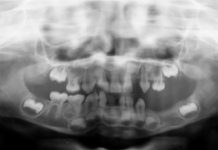Years ago, when someone mentioned yoga to me, my mind conjured up an image of posed individuals meditating while practicing serious dragon breathing in a room full of incense and feng shui music. As a runner, I began reading articles and researching how yoga was beneficial for those who ran. A quick search on the web yielded educational results on yoga as well as free videos to begin my practice.
I struggled through that first class and found a newfound appreciation for the art of yoga. After several years of practice, it is evident how important and beneficial it is for the dental professional as well.
High Risks for Dental Professionals
Dental professionals are more at risk of developing musculoskeletal disorders (MSD) than any other health professional.1 The CDC defines musculoskeletal disorders as injuries to the muscles, nerves, tendons, joints, and the supporting structures of the upper and lower limbs, neck, and lower back that are caused, precipitated, or exacerbated by sudden exertion or prolonged exposure to physical factors such as repetition, force, vibration, or awkward posture.2
The static positions accompanied by repetition that dental professional’s bodies endure over the course of the day place the dental professional at risk for a related injury. Work-related MSDs account for some of the most frequently reported causes of lost or restricted work time.3 Studies report that 87% of dental professionals reported at least one musculoskeletal disorder in a 12-month time frame, with 63% to 93% reporting a prevalence in MSDs.4
While practicing ergonomics helps alleviate or reduce MSDs, it is still equally important to physically take care of our bodies when not at work. The static positions dental professionals maintain can create an unhealthy imbalance of muscles. Awareness of posture and developing strength can help create stability that will assist in work functionality. Yoga proves to be an excellent practice to assist in these matters.
Core Strength for Dental Professionals
Yoga is the practice that helps release muscle tension, as well as increase flexibility and muscle strength.4,5 Yoga also concentrates on meditation and mind-body connectivity. The postures (asanas) and breathing exercises (pranayama) harmonize the physiological system and initiate a relaxation response in the nervous and endocrinal systems.
A survey among 220 dentists found a statistically significant difference in the prevalence of musculoskeletal pain among those practicing yoga compared to those with no regular activity over a period of 12 months.6,8 Prior to the study, 76 dentists reported musculoskeletal pain over the previous 12 months with different intensities. Of the 220 participants, 61.82% were not practicing any physical activity, and 17.28% were already practicing yoga. Those practicing yoga reported only a 10.5% prevalence of MSD pain, while those who did not practice any physical activity reported 45.6%.6,8 Most of the pain reported was in the neck and lower back regions.
Yoga can serve to help properly align the spine, strengthen the core, and help with flexibility that can assist dental professionals as they provide oral health care. Yoga even serves to help improve other exercise tolerance by increasing flexibility and stamina in which other exercise activities require. This will only further improve the physical condition of the body. Core strength is another area of focus in yoga that can greatly benefit the dental professional. Core strength helps the posture as well as reduces lower back pain.7
The flexibility of yoga can also be seen in that it can be practiced in between patients as well as at home. Chair yoga can help give your body a quick reset during the day. Most dental professionals suffer greatly in the neck, back, and shoulder regions. Therefore, these regions will greatly benefit from extra attention.
The asanas in yoga help strengthen muscles in the neck that tend to become weak and deconditioned in professionals who have chronic neck pain.4 These simple stretches only take a few minutes to accomplish and can easily be done between patients or while waiting on the doctor for a patient exam. Beginning and ending your day with stretching is also another great way to dial your body back to health.
Chairside Stretches
Neck – While seated in the operator chair, sitting as far back as possible to support the lower back with feet wide and feet flat to the floor, tuck the chin slightly into the chest while keeping the shoulders relaxed and down. Place the right ear to the right shoulder and gently place the right hand on the head, applying slight pressure until a stretch is felt on the side of the neck. Hold for eight to 10 breaths and then repeat on the opposite side.
Now interlock the hands behind the neck and slightly push the chin forward until a stretch is felt in the back of the neck. Hold for eight to 10 breaths. Repeat by slightly tilting the head backward.
Shoulder/back stretch – To counterbalance the forward slouching motion that many dental professionals unintentionally place themselves in while working, follow this stretch. Interlace the fingers behind the back and pull down gently to pull the shoulders away from the ears, holding for eight to 10 breaths. To stretch the back, interlace the fingers in front of you and pull your heads slightly higher than chest height as you round the back as you pull through the hands until you feel a stretch in the upper back. Hold for eight to 10 breaths.
Wrists – Place one arm straight in front of you and then, using the opposite hand, pull the fingers back so that fingers are facing the ceiling. Now, push the fingers down so that wrists flex and positions the fingers to a downward pointing position facing the floor. Repeat with the opposite hand. Hold each stretch for four to six breaths.
Dental professionals should also consider practicing yoga at home or in a class-based setting to some capacity. While all forms of yoga are beneficial, the dental professional may want to consider Vinyasa, Hatha, Yin, and Anusara.
Yoga will help create flexibility, stamina, and strength to help the dental professional reduce MSDs. Yoga can also help reduce stress, which can help dental professionals cleanse their minds from busy schedules and tense work environments, something I think we could all agree was relevant over the past year. Remember to take care of yourself so that you can take care of others. Now, close your eyes, take a deep cleansing breath, and namaste.
Before you leave, check out the Today’s RDH self-study CE courses. All courses are peer-reviewed and non-sponsored to focus solely on high-quality education. Click here now.
Listen to the Today’s RDH Dental Hygiene Podcast Below:
References
- Brignardello-Petersen, R. Saddle seats seem to reduce the ergonomic risk score compared with conventional seats among dental students. The Journal of the American Dental Association. 2019; 150(6): e100. Retrieved from https://jada.ada.org/article/S0002-8177(19)30098-4/abstract
- Work-Related Musculoskeletal Disorders & Ergonomics Workplace Health Strategies by Condition Workplace Health Promotion. (February 12, 2020). Centers for Disease Control and Prevention. Retrieved from https://www.cdc.gov/workplacehealthpromotion/health-strategies/musculoskeletal-disorders/index.html#
- Ergonomics: Prevention of Musculoskeletal Disorders in the Workplace. (n.d.). United States Department of Labor: Occupational Safety and Health Administration. Retrieved from https://www.osha.gov/ergonomics
- Turagam, N., et al. Benefits of Yoga for Dental Professionals. International Journal of Scientific & Technology Research. 2019; 8(11): 1–4. Retrieved from www.ijstr.org/final-print/nov2019/-Benefits-Of-Yoga-For-Dental-Professionals.pdf
- Graser, J. (2019, March). Pilates? That’s Like Yoga, Right? Pilates Method Alliance. Retrieved from https://www.pilatesmethodalliance.org/
- Ramanathan, M. Yoga for Dental Professional: Scope and Simplified Practices. Journal of Scientific Dentistry. 2017; 7(1): 1–11. doi:10.5005/jsd-7-1-1.
- Improve Your Balance by Strengthening Your Core. (2014, February). Harvard Health. Retrieved from https://www.health.harvard.edu/balance-and-mobility/improve-your-balance-by-strengthening-your-core#
- Suneetha, K., Tanikonda, R. Role of Yoga and Physical Activity in Work-related Musculoskeletal Disorders among Dentists. Journal of International Society of Preventive & Community Dentistry. 2015; 5(3): 199-204. doi:10.4103/2231-0762.159957.












